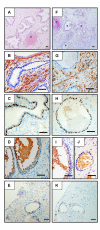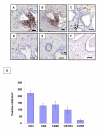Human prostate supports more efficient replication of HIV-1 R5 than X4 strains ex vivo
- PMID: 19117522
- PMCID: PMC2649003
- DOI: 10.1186/1742-4690-5-119
Human prostate supports more efficient replication of HIV-1 R5 than X4 strains ex vivo
Abstract
Background: In order to determine whether human prostate can be productively infected by HIV-1 strains with different tropism, and thus represent a potential source of HIV in semen, an organotypic culture of prostate from men undergoing prostatic adenomectomy for benign prostate hypertrophy (BPH) was developed. The presence of potential HIV target cells in prostate tissues was investigated using immunohistochemistry. The infection of prostate explants following exposures with HIV-1 R5, R5X4 and X4 strains was analyzed through the measure of RT activity in culture supernatants, the quantification of HIV DNA in the explants and the detection of HIV RNA+ cells in situ.
Results: The overall prostate characteristics were retained for 21/2 weeks in culture. Numerous potential HIV-1 target cells were detected in the prostate stroma. Whilst HIV-1 R5SF162 strain consistently productively infected prostatic T lymphocytes and macrophages, the prototypic X4IIIB strain and a primary R5X4 strain showed less efficient replication in this organ.
Conclusion: The BPH prostate is a site of HIV-1 R5 replication that could contribute virus to semen. A limited spreading of HIV-1 X4 and R5X4 in this organ could participate to the preferential sexual transmission of HIV-1 R5 strains.
Figures





References
-
- Dejucq-Rainsford N, Jégou B. Viruses in semen and male genital tissues: consequences for the reproductive system and therapeutic perspectives. Current Pharmaceutical Design. 2004;10:557–575. - PubMed
-
- Zhang H, Dornadula G, Beumont M, Livornese LJ, Van Uitert B, Henning K, Pomerantz RJ. Human immunodeficiency virus type 1 in the semen of men receiving highly active antiretroviral therapy. N Engl J Med. 1998;339:1803–1809. - PubMed
-
- Kiessling AA, Fitzgerald LM, Zhang D, Chhay H, Brettler D, Eyre RC, Steinberg J, McGowan K, Byrn RA. Human immunodeficiency virus in semen arises from a genetically distinct virus reservoir. AIDS Res Hum Retroviruses. 1998;14:S33–S41. - PubMed
-
- Mayer KH, Boswell S, Goldstein R, Lo W, Xu C, Tucker L, DePasquale MP, D'Aquila R, Anderson DJ. Persistence of human immunodeficiency virus in semen after adding indinavir to combination antiretroviral therapy. Clin Infect Dis. 1999;28:1252–1259. - PubMed
-
- Lafeuillade A, Solas C, Halfon P, Chadapaud S, Hittinger G, Lacarelle B. Differences in the detection of three HIV-1 protease inhibitors in non-blood compartments: Clinical correlations. HIV Clin Trials. 2002;3:27–35. - PubMed
Publication types
MeSH terms
LinkOut - more resources
Full Text Sources
Medical

